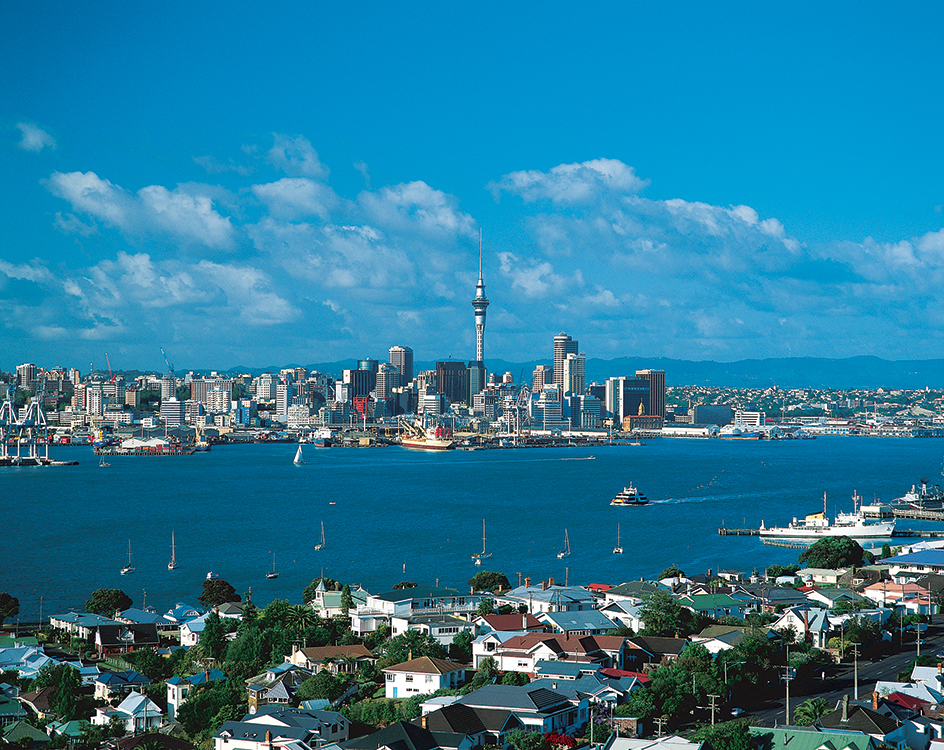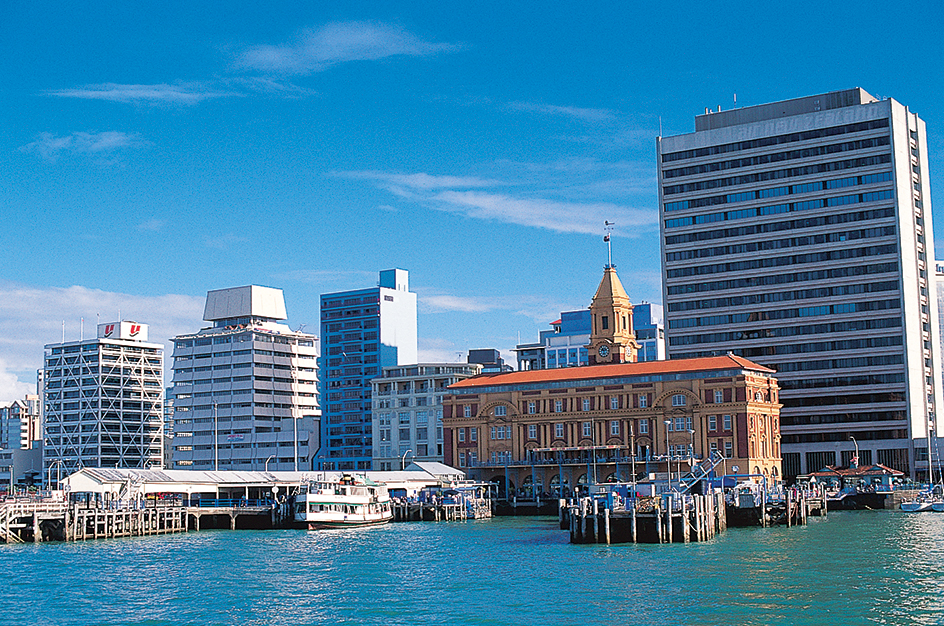Auckland << AWK luhnd >> (pop. 1,571,718) is New Zealand’s largest city and chief commercial center. About a third of the nation’s people live in Auckland, which covers about 2,200 square miles (5,600 square kilometers).

Central Auckland lies on a narrow isthmus (strip of land) on New Zealand’s North Island. To the north is Waitemata Harbour, which opens eastward into Hauraki Gulf. To the south is Manukau Harbour, which opens westward into the Tasman Sea. The Coromandel << KAWR uh MAN duhl >> Peninsula and an island chain in the Hauraki Gulf shelter Waitemata Harbour from the Pacific Ocean. Hills surround Hauraki Gulf. Auckland extends about 40 miles (65 kilometers) north and 40 miles (65 kilometers) south of the city center. The Auckland area has many volcanic craters and mounds, some of which the early Māori developed as pā (fortified villages).
The metropolitan area
Central Auckland is a busy commercial hub. The business district is concentrated around Queen Street. City communities, such as Newmarket, Parnell, and Ponsonby, feature fashionable shops and restaurants. The Sky Tower, Mount Eden, and One Tree Hill offer fine views of the city.

Waiheke Island, a large island in Hauraki Gulf, lies near the entrance to Waitemata Harbour. The island has a small population that varies depending on the season. Many of the full-time residents commute daily to the mainland. Rangitoto Island, 853 feet (260 meters) high, dominates the harbor skyline. The harbor’s name, Waitemata, is Māori for water smooth as obsidian.
Manukau Harbour has extensive mudflats and sandbanks. Its name may come from the Māori word mānukanuka, meaning anxiety, because a large sandbank at the harbor’s entrance posed a danger to Māori sailors. The sandbank and narrow, winding channels leading to the Port of Onehunga make the harbor unsuited to large, oceangoing vessels.
The western suburbs of Auckland rise toward the beautiful Waitakere Ranges, where the highest peak rises 1,556 feet (474 meters) above sea level. West of the Waitakere lie a number of rugged beaches. In the Henderson Valley, also west of the city, farmers grow fruit and make wine. Commercial gardens, dairy farms, and industrial areas lie south of Auckland.

People
Auckland is home to immigrants from many countries. About two-fifths of Aucklanders were born overseas. Over half of Auckland’s people are of European ancestry. More people of Polynesian descent live in Auckland than in any other city in the world. They include the city’s Māori population, along with such groups as Niueans, Samoans, and Tongans. Auckland is also home to a large Asian population, including many people of Chinese and Indian descent. English is the main language used in Auckland. A number of Asian and Polynesian languages are also spoken in the city.
Education and culture
Education.
The University of Auckland, which opened in 1883, is one of New Zealand’s largest universities. It includes a school of theology, plus faculties of arts, business, education, engineering, law, medicine, and science. The Auckland area is also home to Massey University, the Manukau Institute of Technology, and the Auckland University of Technology.
Architecture.
Auckland has some good examples of the area’s early architecture. Auckland’s oldest building, Acacia Cottage, was built in 1841 by John Logan Campbell and William Brown, two Scottish pioneers. The cottage, made from planks of native kauri wood, was moved from its original site in central Auckland to Cornwall Park in 1920. Highwic, a Gothic-style timber house with antique furnishings and fine gardens, was built about 1862. Many changes were made to the building in the 1870’s and 1880’s. Kinder House dates back to about 1857. This stone structure contains paintings and photographs of early New Zealand by John Kinder, an early settler.
Museums and libraries.
The Auckland War Memorial Museum, also known as the Auckland Museum, opened at its present site in 1929. The museum honors New Zealanders who served in World War I (1914-1918). Additions to the museum commemorate veterans of World War II (1939-1945). The museum also houses a large collection of Māori and other Polynesian arts and crafts as well as a library of Pacific area literature.
The Auckland Art Gallery Toi o Tāmaki has a notable collection of New Zealand and European artwork. Exhibits at the Museum of Transport and Technology feature early agricultural equipment, vintage vehicles, and communications technology. The museum’s Sir Keith Park Memorial Aviation Collection exhibits airplanes and other items devoted to New Zealand’s aeronautical history. The Auckland City Libraries have branches throughout the city.
Performing arts.
Local and touring theater groups perform at the University of Auckland’s Maidment Theatre, the Auckland Town Hall, the Aotea Centre, The Civic, and other facilities. The Aotea Centre and the Town Hall also present musical concerts that feature local and international artists. The city supports its own orchestra, the Auckland Philharmonia Orchestra. The Western Springs Stadium and the Logan Campbell Centre often host visiting musical artists. The stadium also hosts sporting events and the Campbell Centre also hosts conventions.
Recreation.
The Auckland area has many parks and beaches. The city’s principal parks include Albert Park, Auckland Domain, Cornwall Park, One Tree Hill, and the Parnell Rose Garden. The Auckland Zoo is at Western Springs. Sea Life Kelly Tarlton’s Aquarium, on the waterfront, is a large aquarium. Howick Historical Village re-creates colonial life in the mid-1800’s. The city also has a number of amusement parks, art galleries, golf courses, and markets.
Auckland is a major sailing center. Nicknamed the “City of Sails,” it is known for the many yachts seen in its harbors. Every January, hundreds of yachts arrive in Waitemata Harbour to take part in a huge one-day regatta. Harbor cruises and scenic flights are available the year around.
Economy
Shipping.
The Port of Auckland, at Waitemata Harbour, is New Zealand’s chief port. Shipping routes link Auckland’s ports with dozens of countries. A number of passenger cruise ships also dock at the port.
Industry.
Manufacturing provides employment for a large number of people in the Auckland region. Manufacturers in Auckland produce chemical products, clothing, food products, machinery, metal products, plastic products, printed materials, ships and boats, and textiles.
Communications.
The New Zealand Herald, a daily newspaper, is published in Auckland. Established in 1863, it is New Zealand’s largest metropolitan daily. The Auckland region also has a number of suburban newspapers. Printing and publishing are leading industries in the Auckland area.
Transportation.
A system of buses operates within Auckland. Buses and trains connecting downtown Auckland with other parts of the metropolitan area leave from the Britomart Transport Centre, which is near the Downtown Ferry Terminal. Railroad lines and several highways link Auckland with other cities on the North Island. The Auckland Harbour Bridge connects the city with the North Shore of Waitemata Harbour.
Auckland Airport, in the suburb of Mangere, is New Zealand’s busiest airport. Charter companies, flying clubs, and a flight school operate out of Ardmore Airport, about 20 miles (32 kilometers) south of Auckland’s business district.
Government
The Auckland Council consists of a mayor and 20 councilors. The people elect these officials to three-year terms. Auckland also has 21 local boards that handle community issues and serve as a link between communities and the Auckland Council. The Auckland metropolitan area includes the urban parts of the cities of Auckland, Manukau, North Shore, and Waitakere and of the districts of Franklin, Papakura, and Rodney.
History
Archaeologists have found signs that ancestors of the Māori people lived in the Auckland area before A.D. 1300. Periodically, various Māori iwi (tribes) fought for possession of the rich farmland and the harbor fishing grounds. They built fortified villages, with stockades and trenches, on top of many of the volcanic mounds in the area. They also cut terraces into the sides of the mounds to grow crops. About 1750, an iwi called Ngāti Whātua gained complete control of the Auckland region.
In the early 1800’s, fighting flared up between Māori groups throughout New Zealand. War parties used Auckland’s isthmus as a land route for transporting their canoes between the Waitemata and Manukau harbors and the river systems that flow into them. Many local people fled the Auckland region during this period of warfare, but they began to return to the area in the late 1830’s.
Historians do not know who was the first European to land at the present site of Auckland. In November 1769, the British explorer James Cook sailed into the Hauraki Gulf. He passed to the east of Waiheke Island but did not see the entrance to Waitemata Harbour or the city’s present site. Whalers seeking kauri wood for their ships probably visited the harbor as well. But it was not until 1820 that the English missionary Samuel Marsden entered the harbor and made the first recorded crossing of the isthmus.
In 1840, the lieutenant governor of New Zealand, William Hobson, decided to shift the capital from Russell to the area around Waitemata Harbour. He named the area after Lord Auckland, who was then governor general of India. Also in 1840, Hobson and many local Māori chiefs signed the Treaty of Waitangi. This treaty gave the United Kingdom the right to govern New Zealand. In return, the British government guaranteed the local Māori the full ownership of all their lands for as long as they wished to keep them and granted them the rights of British citizenship. However, European infringement upon Māori lands led to conflicts in the following years.
An official ceremony establishing the town of Auckland took place on Sept. 18, 1840. In October, a group of Māori chiefs sold about 3,000 acres (1,200 hectares) of land at the site of Auckland to the New Zealand government. Governor Hobson moved to Auckland in March 1841. In October 1842, the Duchess of Argyle and the Jane Gifford arrived from Greenock, Scotland. These ships carried about 500 settlers to the area. In 1851, Auckland was proclaimed a borough (city). However, the elected borough council was unable to establish an effective government and was dissolved the next year.
Thriving trade and a gold rush at Coromandel in 1852 caused the city to grow. In 1854, a second Auckland City Council was established. However, like the previous council, it could not govern effectively. In 1856, the council was dissolved. In 1865, Wellington replaced Auckland as the national capital. In 1871, Auckland was again declared a borough and another Auckland City Council was established.
During World War II (1939-1945), Auckland served as a military base for the Allied campaign in the Pacific. In 1950, the city hosted the British Empire Games (now called the Commonwealth Games), an amateur sports competition. In 1959, the Auckland Harbour Bridge opened.
New Zealand’s government declared the country a nuclear-free state in the 1980’s. During a period of friction between New Zealand and France, which was testing nuclear weapons in the Pacific Ocean, French agents sank the Greenpeace ship Rainbow Warrior in Auckland Harbour. Greenpeace is an international environmental organization. In 1990, Auckland again hosted the Commonwealth Games. The city hosted the America’s Cup yacht race in 2000 and 2003. In 2010, Auckland replaced its system of city and district councils with one centralized governing organization, the Auckland Council.
See also Māori; New Zealand, History of.
